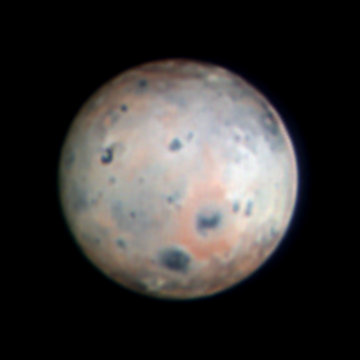Glimpses of a volcanic world: New telescope images of Jupiter's moon Io rival those from spacecraft

Press release by Daniel Stolte, University Communications
The images, to be published in the journal Geophysical Research Letters, reveal surface features as small as 50 miles across, a spatial resolution that until now had been achievable only with spacecraft sent to Jupiter. This is equivalent to taking a picture of a dime-sized object from 100 miles away, according to the research team. SHARK-VIS allowed the researchers to identify a major resurfacing event around Pele, one of Io’s most prominent volcanoes. According to the paper’s first author, Al Conrad, the eruptions on Io, the most volcanically active body in the solar system, dwarf their contemporaries on Earth.
“Io, therefore, presents a unique opportunity to learn about the mighty eruptions that helped shape the surfaces of the Earth and the moon in their distant pasts,” said Conrad, associate staff scientist at the Large Binocular Telescope Observatory. The Large Binocular Telescope, or LBT, is part of Mount Graham International Observatory, a division of the University of Arizona Steward Observatory.
Conrad added that studies like this one will help researchers understand why some worlds in the solar system are volcanic but not others. They also may someday shed light on volcanic worlds in exoplanet systems around nearby stars.
Slightly larger than Earth’s moon, Io is the innermost of Jupiter’s Galilean moons, which in addition to Io include Europa, Ganymede and Callisto. Locked in a gravitational “tug of war” among Jupiter, Europa and Ganymede, Io is constantly being squeezed, leading to frictional heat buildup in its interior – believed to be the cause for its sustained and widespread volcanic activity.

INAF/Large Binocular Telescope Observatory/Georgia State University; IRV-band observations by SHARK-VIS/F. Pedichini; processing by D. Hope, S. Jefferies, G. Li Cau
By monitoring the eruptions on Io’s surface, scientists hope to gain insights into the heat-driven movement of material underneath the moon’s surface, its internal structure and ultimately, on the tidal heating mechanism responsible for Io’s intense volcanism.
Io’s volcanic activity was first discovered in 1979, when Linda Morabito, an engineer on NASA’s Voyager mission, spotted an eruption plume in one of the images taken by the spacecraft during its famous “Grand Tour” of the outer planets. Since then, countless observations have been made that document Io’s restless nature, from both space and Earth-based telescopes.
Study co-author Ashley Davies, a principal scientist at NASA’s Jet Propulsion Laboratory, said the new image taken by SHARK-VIS is so rich in detail that it has allowed the team to identify a major resurfacing event in which the plume deposit around a prominent volcano known as Pele, located in Io’s southern hemisphere close to the equator, is being covered by eruption deposits from Pillan Patera, a neighboring volcano. A similar eruption sequence was observed by NASA’s Galileo spacecraft, which explored the Jupiter system between 1995 and 2003.
“We interpret the changes as dark lava deposits and white sulfur dioxide deposits originating from an eruption at Pillan Patera, which partially cover Pele’s red, sulfur-rich plume deposit,” Davies said. “Before SHARK-VIS, such resurfacing events were impossible to observe from Earth.”
While telescope images in the infrared can detect hot spots caused by ongoing volcanic eruptions, they are not sharp enough to reveal surface details and unambiguously identify the locations of the eruptions, explained co-author Imke de Pater, professor emerita of astronomy at the University of California – Berkeley.
“Sharper images at visible wavelengths like those provided by SHARK-VIS and LBT are essential to identify both locations of eruptions and surface changes not detectable in the infrared, such as new plume deposits,” de Pater said, adding that visible light observations provide researchers with vital context for the interpretation of infrared observations, including those from spacecraft such as Juno, which is currently orbiting Jupiter.
SHARK-VIS was built by the Italian National Institute for Astrophysics at the Rome Astronomical Observatory and is managed by a team led by principal investigator Fernando Pedichini, assisted by project manager Roberto Piazzesi. In 2023, it was installed, together with its complementary near-infrared instrument SHARK-NIR, at the LBT to fully take advantage of the telescope’s outstanding adaptive optics system. The instrument houses a fast, ultra-low-noise camera that allows it to observe the sky in “fast imaging” mode, capturing slow-motion footage that freezes the optical distortions caused by atmospheric turbulence, and to post-process data to an unprecedented sharpness.
Gianluca Li Causi, data processing manager for SHARK-VIS at the Italian National Institute for Astrophysics, explained how it works: “We process our data on the computer to remove any trace of the sensor’s electronic footprint. We then select the best frames and combine them using a highly efficient software package called Kraken, developed by our colleagues Douglas Hope and Stuart Jefferies from Georgia State University. Kraken allows us to remove atmospheric effects, revealing Io in incredible sharpness.”
SHARK-VIS instrument scientist Simone Antoniucci said he anticipates new observations to be made of objects throughout the solar system.
“The keen vision of SHARK-VIS is particularly suited to observing the surfaces of many solar system bodies, not only the moons of giant planets but also asteroids,” he said. “We have already observed some of those, with the data currently being analyzed, and are planning to observe more.”
Press Release Link available here.

